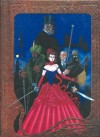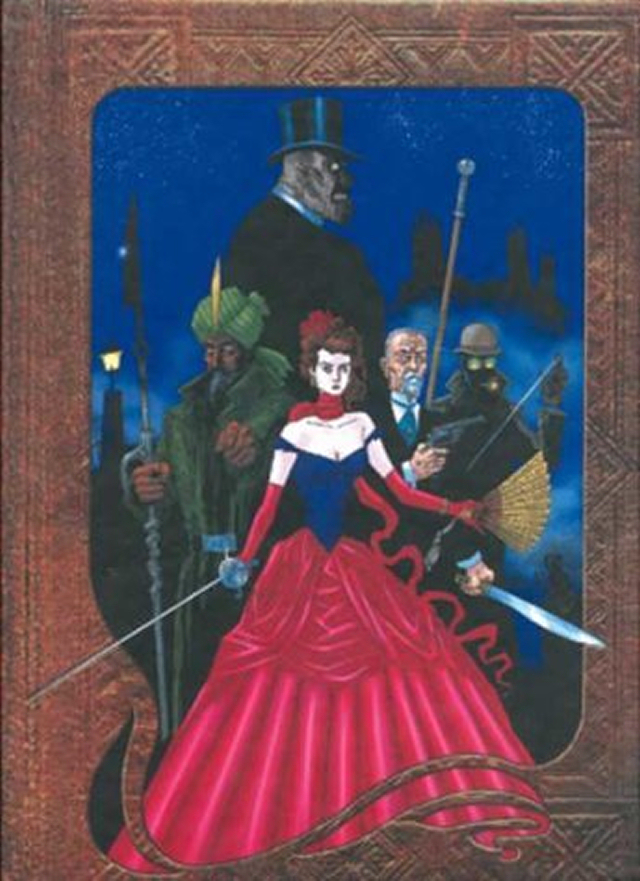
The Plot
Miss Mina Murray has been tasked by the mysterious M to collect a group of the world’s most famous ‘heroes’ to work on behalf of him (and perhaps the British government) in reclaiming the stolen wonder-item cavorite. But said ‘heroes’ are reluctant to join in or cooperate with anyone and things do not go as smoothly as they might.
My Thoughts
I feel like a broken record in some of these recent reviews. What I great idea, I say. But what a disappointing execution, I conclude. Unfortunately, that’s my ultimate opinion with this work as well.
I knew going into this that Alan Moore and I do not get along. I find his female characters at best ignorable and at worst actively offensive. Yet he has such a huge fanbase, I continue to return to his work, expecting… I don’t know. Expecting to find it something else. Expecting to find it the work of staggering genius other people find, people whose taste I mostly respect. But every time I’m disappointed and more disgusted by the flagrant misogyny and pointless violence against women.
The main woman character here is Wilhelmina Murray, now divorced from Jonathan Harker and fresh from her adventures in Dracula. She wears a scarf to hide the bite marks on her neck and is reluctant to discuss any details from her past. Though she’s been tasked to collect the men who will assist in recovering the cavorite, it’s not clear to this reader why at all she was chosen. She exhibits very little by way of personality or engagement, nor does she actually attempt to assert any kind of authority over the men. By the end of the story I still had no idea what her purpose or function was, as she mostly seemed used as a prop or someone to be rescued from the raping hordes. Unlike the male characters, who are defined by the deeds and achievements which they actively courted, she is a most famous victim. In the artwork her figure is grossly distorted, with a waist the size of a toothpick and a bulgy top. This may be an attempt on behalf of O’Neill to create a more period feel to the art, by mimicking advertisements and drawings of the time, but it looks ridiculous compared to the more reasonably shaped and varied men.
Allan Quatermain is Mina’s first recruit, in an opium induced haze after some rather incoherent adventures he experienced and which are recounted in the back of the book. She then proceeds to collect Jekyll/Hyde (busy raping and murdering prostitutes), and the Invisible Man (busy raping and impregnating schoolgirls). At least Captain Nemo isn’t off on a rape spree, but then again, who knows what kind of buggery he’s up to on that submarine of his? Perhaps we just don’t get to see much of anything about his crew because it’s not nearly as much fun to rape sailors.
Characterization issues aside, the plot is standard enough: Supervillain has stolen/acquired an artifact of awesome power that will allow him to achieve global domination, and our heroes are tasked with recovering it and foiling his plans. There are some slight variations, but no new ground is broken on the plot itself.
The main attraction of this work, I think, is the central idea: that Stoker and Haggard and Verne and Wells and Conan Doyle weren’t writing fiction, but were recounting (and exaggerating — perhaps) the exploits of actual people and actual adventures. The world thus created, where fiction and reality are one, is an interesting one.
But (and you knew there was a but coming) there are some issues, perhaps exemplified most simply by the episode which took place at the girls’ school. The team goes out to investigate reports of the “Holy Spirit” impregnating girls and discovers that no, it is not the Holy Spirit but rather the Invisible Man who is raping and molesting the schoolgirls. A random aside from the Headmistress at the end of this episode suggests that one of the victims was Pollyanna. And why is this an issue? Well, for the most part, the fictional characters who are now ‘real’ seem to have their histories intact. Quatermain did experience the adventures Haggard attributed to him; Nemo has the Nautilus, the Invisible Man is invisible, Moriarty is a super genius nemesis to Holmes. And then we have Pollyanna Whittier, a little girl from Vermont, suddenly appearing at a random (reform?) school outside of London. What? Oh, I’m sure the impulse to include the reference was too much of a joke to resist, but surely there were English schoolgirls it would have made much more sense to include.
But I found the disrespect to a work that I happened to enjoy (written by a woman and fellow New Englander) a bit galling. I know there are quite a lot of asides and in jokes that I probably didn’t pick up on in the book, because while I’m familiar with a lot of these stories, I’m not actually a huge fan of Victorian supernatural or speculative fiction. So points which would only be appreciated by fans or people widely read in that genre are lost on me. I didn’t notice (aside from Pollyanna, and I could have done without that one) many asides directed toward the kind of literature from that time which I have read, namely children’s books, or books by women authors which are now classified as children’s, though they were originally intended for all ages.
In Short
The idea of this book is a great one, but the comic itself suffers from a poor representation of women overall and the weakness of its one main female character. (And I do wonder why, with all of literature to choose from, we once again end up with a team of all men save one token — very token — female). And the relatively pedestrian plot doesn’t do much to redeem these problems. For the ardent fan of Victorian speculative fiction there are probably enough references and in jokes to get over these issues, but I’m uncertain whether it would be worth it to read further on in the series in hopes of improvement or if I should just give it up now as a bad business.


Glad to see it wasn’t just me!!! While writing my review, I thought I was harping on the raping too much. But no, there was just too much raping going on!
I didn’t catch as many references as you did. It might have actually annoyed me more if I had.
I’m certainly not going to read any more of it.
(At least I was right about the bite marks. But it seems to mean she was only bitten, not that she’s a vampire herself? If she is, she’s a really bad one. Or maybe she’s a baby vampire and hasn’t grown into her powers yet. Though we pointedly don’t see her eating anything.)
That was a longer paranthetical than I meant it to be. :)
I think the implication at the end of Dracula is that Mina did not become a vampire. I believe the movie version of LXG gives her vampire powers. I’d probably prefer the former if without the added supernatural powers she could be a stronger and less useless character.
It makes me so sad when books I’ve heard are great turn out to be rubbish.
Oh, I didn’t catch that Pollyanna reference at all. I can see how that would’ve bothered you a lot.
I’m sure there were plenty of references I missed, though I think there may’ve been a Trollope one. There was some mention of Palliser, at any rate.
Also, this is a great point: “Unlike the male characters, who are defined by the deeds and achievements which they actively courted, she is a most famous victim.” We never do know why Mina has been tasked with this assignment or what skills she has that merit her inclusion in this group.
That drove me wild. It’s almost as if we -had- to start with her already recruited because any attempt to explain her initial involvement would have made no sense — and the author knew it.
That’s plausible. Maybe v2 will address this, but I rather doubt it.
The movie seems to have felt this problem too, because iirc it gives her awesome vampy powers to make her less useless.
ha! Looking back at the comments I see I made nearly the exact same one a month and a half ago. Glad to see my opinion is the same.